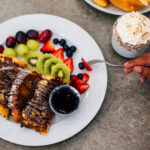
Everything You Need to Know About Puerto Rico’s Bioluminescent Bays
Drifting through a sparkling ocean, witnessing the rare, natural light show known as bioluminescence is an unforgettable experience.
There are just five bioluminescent bays in the world and Puerto Rico is home to three—Vieques, Laguna Grande and La Parguera. The other two are Jamaica’s Luminous Lagoon and Halong Bay in Vietnam. Snorkeling and kayaking excursions to a bio bay provide exhilarating close encounters with this rare biochemical emission of light. Each ripple caused by either the oar, the gentle flap of a nearby fish or a hand skimming the water ignites magical fluorescent-blue sparkles below the surface. Choosing which bay to visit depends on how much time you have, the type of experience you are looking for, price and accessibility.

What is bioluminescence?
This ethereal phenomenon occurs in tropical locations when billions of microorganisms called dinoflagellates (a type of plankton) are concentrated in one place, giving the water an almost psychedelic bright, blue-green glow. Bioluminescence is more commonplace than you might think—fireflies are the obvious example. Many species can control the intensity and color of the light they emit. In Puerto Rico’s bio bays, the dinoflagellate response is purely reactive. When the organisms are disturbed by subtle movements in the water, a protein and an enzyme—luciferin and luciferase—combine and create energy. Scientists speculate that dinoflagellates developed this trait to ward off or evade predators and for communication.
How can I experience a bio bay in Puerto Rico?
To access Puerto Rico’s bio bays via kayak or paddleboard, you’ll need to paddle through dark mangrove channels—we recommend that you sign up with a recommended tour operator. Most tour companies operate two tours each night, at sunset and 9pm. Tandem kayaks—the most common vessel—allow for a unique family-friendly experience; most operators specify a minimum age of six years to participate. Kayaks are generally towed out to the lagoon. The channels are protected by outer reefs and mangroves so you can expect calm conditions with no currents. Regardless of which bio bay you choose, always try to schedule your tour on a cloudy, moonless night to allow for ideal viewing.
Note that there are no bio bay tours the day before, of and after the full moon.

Vieques Bioluminescent Mosquito Bay
The protected wildlife reserve of Bahía Mosquito is located on Vieques, an island municipality just a 40-minute ferry ride from Ceiba, or a short flight from San Juan. Famed for its picture-perfect crescents of sand, boutique hotels and crystalline waters, Vieques fulfills every classic Caribbean fantasy.
Boasting the highest concentration of phosphorescent dinoflagellates, Mosquito Bay is universally hailed as the brightest of the world’s five bio bays. It’s also Puerto Rico’s most logistically challenging—you’ll need to secure reservations well in advance and stay overnight on the island; but that’s certainly no hardship. Kayaking through the bay under star-studded skies is a mesmerizing experience. Most tours leave from Esperanza, on the south of the island, a 15-minute drive from the airport. It’s the island’s laid back tourist hub with a handful of restaurants, bars and outfitters dotting the oceanfront Malecón. As Mosquito Bay forms part of the Sun Bay Nature Reserve, swimming here is not permitted and the bay is only open to licensed tour companies with permits, not individuals.
Getting to Vieques
By Plane
There are several flights a day from San Juan international Airport (SJU) with Cape Air and Vieques Air Link. Flights start at $110 one way; airtime is around 30 minutes. From San Juan’s Isla Grande Airport (SIG), 10 minutes from downtown San Juan, there are flights with Cape Air, Air Flamenco and Vieques Air Link. One-way tickets cost from $72 each way; airtime around 17 minutes. There are also daily flights from Ceiba Airport with Vieques Air Link, from $40 (7-min. flight time)
By Ferry
The less convenient alternative is a 45-minute public ferry ride (less than $5) from Ceiba, a 90-minute drive from San Juan (taxi fare around $170). The ferry schedules are notoriously erratic. Always try to reserve a seat on the earliest ferry—getting bumped isn’t unusual.
Getting around Vieques
Car Rental
Hiring a car is the best way to explore the island. Vieques’ interior is wild and rugged, so a 4-wheel drive vehicle is recommended. Demand for rental cars frequently outstrips supply—driving higher prices. Expect to pay around $100 per day for a Jeep (or equivalent), around $70 per day for a golf cart. Be sure to make a reservation well ahead of time. There are several rental companies at the airport: Vieques Car Rental, Avis and Coqui Car Rental. If you decide not to rent a car, it’s best to stay in Esperanza, the tourist epicenter.
Taxi
The two main services on Vieques are Vieques Taxi (787-741-8294) and Mode’s transportation services (787-295-3021).
Publicos
You’ll find publicos waiting at Vieques’ ferry terminal and airport as well as in the towns of Isabel Segunda and Esperanza. Publicos operate on fixed routes, fares can range from $3–$5 per person. A shared ride will lower the cost further.
Recommended Tour Operators
Jak Watersports
One of Vieques’ leading outfitters, Jak’s small group tours use clear, tandem canoes which enhance the experience by illuminating as you cruise through the bay. Paddle boards, motorboats and regular kayak excursions are also offered. Jak’s is known for its professional, knowledgeable guides. Two-hour tours ($60) leave from the docks in Esperanza at sunset and 9pm.
Abe’s Snorkeling & Bio Bay Tours
Two-hour excursions in tandem kayaks depart at 7pm nightly ($60 adults, $45 kids aged 4-11). A family-run outfit, Abe’s offers flexible booking, experienced guides and a family-friendly focus. The All-in-One (snorkeling and bio bay tour) is the most popular option.
Vieques Kayak Bio Bay
Small group, 90-minute bio bay excursions in clear and semi-clear kayaks depart nightly from Esperanza at 7pm and 9pm (price $50).
La Parguera Bioluminescent Bay
The rustic fishing village of La Parguera lies 126km (78 miles) southwest of San Juan and 42km (26 miles) west of Ponce. Facing calm, clear Caribbean waters, sheltered by mangrove forests, the southwest region is a haven for watersport enthusiasts or every ilk.
One of Puerto Rico’s great ecological treasures, La Parguera bioluminescent bay draws visitors to the captivating light displays at its (technically) two bio bays: Bahía la Parguera and Bahía Monsio Jose. As a result of overdevelopment and pollution, the bio bays here pale in comparison to the brightness of Vieques (six times brighter by some estimates) and Laguna Grande (Fajardo).
La Parguera still provides a rewarding experience and offers several advantages over its peers. It’s cheaper, receives less visitors and it’s the only bay where you enjoy nocturnal swimming. You can also combine a trip with exceptional snorkeling and diving. Most tours in La Parguera allow 40 minutes to swim in the bay. While we recommend that you take a guided tour with a licensed tour company, a handful of boat operators at the docks will negotiate a rate to take you out in the bay; around $15 per person.
Getting to La Parguera
The fastest route from San Juan takes just over two hours, via Expressway PR-52 and then PR-304, which funnels to the seafront, the hub of tourist activity. There are three flights daily from San Juan (SJU) to Mayagüez Airport (MAZ) which is 32.5km (20 miles) from La Parguera. One-way Cape Air flights cost from $40.
Recommended Tour Operators
Paradise Scuba Snorkeling
Paradise’s most popular option is the combined snorkeling and bio bay tour led by guides from the Professional Association of Diving Instructors (PADI): 4-hour tours depart at 4pm (price $85). If you just want to snorkel in the bio bay (45 minutes), tours depart at 6pm and 9pm (price $55).
Bio Bay Parguera
This highly rated, family-owned tour company offers several bio bay tour options; standard kayak tours of the bay leave at 6:30pm and 9pm (price $62). The sunset swim tour at 4pm includes excellent snorkeling at the reef.
Fondo de Cristal
The 150-passenger Fondo de Cristal operates glass-bottomed catamaran tours where you experience the dinoflagellates light up around the boat and through the glass bottom viewing areas. 50-minute tours depart from Esperanza’s marina nightly at 7:30pm, 8:30pm, 9:30pm and 10:30pm (price from $10).
Laguna Grande, Fajardo
Less than an hour’s drive from San Juan, on the Northeast Coast, Laguna Grande is the most accessible bioluminescent bay in Puerto Rico. Fajardo is the second brightest bay of the trio, although light pollution from nearby towns is still very much present. What sets Laguna Grande apart is that the bio bay is actually a lagoon, nestled within an area of spectacular natural beauty. The lagoon forms part of Las Cabezas de San Juan Nature Reserve, one of the most gorgeous and ecologically important areas in Puerto Rico—seven eco-zones thrive within a compact area. The ability to visit the bio bay on a day trip from San Juan is a huge part of the appeal. As such, you should expect large numbers of visitors, especially on the weekend and holidays.
Part of the experience is the journey to the lagoon. Kayaks launch from a concealed opening in the mangroves at the northern end of the beach then navigate a mile-long channel. The dinoflagellates put on their ethereal light show as they feast off the red mangroves that surround the water.
Getting to Fajardo
If you’re driving from San Juan, head east along the Rte. 66 Corridor Noreste highway and then follow Rte. 3 toward Fajardo—you’ll find a surfeit of tasty local restaurants and kiosks along the route. Fajardo and the Northeast Coast are the epicenter of many of Puerto Rico’s bucket-list attractions; El Yunque National Forest is just a short drive away.
Recommended Tour Operators
Kayaking Puerto Rico
This innovative adventure company specializes in eco-friendly bioluminescent bay excursions along Puerto Rico’s Northeast Coast. Two-hour bio bay tours depart from Las Croabas at 6:15pm and 8:30pm daily (price $55). Travelers short on time can combine a guided hike of El Yunque with an evening bio bay tour (price $149), including transportation from San Juan, a stop in Luquillo and dinner at a local restaurant.
Ecoadventures
Daily two-hour tours depart from Las Croabas at 6:15pm and 8:15pm (price $48). Following a short briefing on how to kayak and minimize your environmental footprint, you’ll navigate the mangrove channels that lead to the lagoon. Knowledgeable guides provide insight into the unique flora, fauna and sea life that inhabit this magical ecosystem.
Island Kayaking Adventures
Night kayak paddling tours into Laguna Grande (price $53) depart Monday to Saturday at 6pm or 8pm (Oct–Feb), 6:30pm or 8:30pm (Mar-Sept).
Las Tortugas Adventures
Highly rated tours are run by experienced guide Gary Horne, certified dive master and Coast Guard veteran. Two nightly tours of the bay, at 6pm and 8pm, cost $55 per person, or $75 including round-trip transportation from San Juan.
Tips for visitors
- Wear comfortable waterproof or (ideally) hybrid clothing and shoes that can get wet. Flip flops and slides work.
- Bring a towel and change of clothes for after the tour.
- To minimize environmental impact, avoid wearing sunscreen, lotion and insect repellant.
- Visiting a bio bay is a family friendly experience. Most tour operators specify a minimum age of 6 years old. Children under 13 must also be accompanied by an adult.
- It’s best to visit during a New Moon phase—on a dark and cloudy evening—when the bioluminescent glow is most pronounced.
- Bio bays are extremely hard to photograph. You’ll need to bring along a camera that has manual settings for ISO, shutter speed and aperture, and ensure the flash is turned off.






